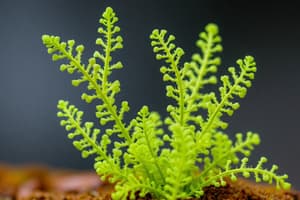Podcast
Questions and Answers
How are gymnosperms different from angiosperms?
How are gymnosperms different from angiosperms?
- Gymnosperms are perennial and woody (correct)
- Gymnosperms have flowers
- Gymnosperms are smaller in size
- Gymnosperms require more water
What is a characteristic of gymnosperms?
What is a characteristic of gymnosperms?
- They have flowers
- They are more recent than angiosperms
- They are present in cold areas (correct)
- They are annual plants
What replaced gymnosperms in warmer areas?
What replaced gymnosperms in warmer areas?
- Algae
- Ferns
- Mosses
- Angiosperms (correct)
Where are gymnosperms present today?
Where are gymnosperms present today?
How old are gymnosperms compared to angiosperms?
How old are gymnosperms compared to angiosperms?
Which of the following is an example of a gymnosperm?
Which of the following is an example of a gymnosperm?
Flashcards are hidden until you start studying
Study Notes
Differences between Gymnosperms and Angiosperms
- Gymnosperms have seeds that are naked, meaning they are exposed and not enclosed in ovaries like angiosperms
- Angiosperms, on the other hand, have seeds that are enclosed in ovaries
Characteristics of Gymnosperms
- One characteristic of gymnosperms is that they produce seeds that are exposed on the surface of scales or leaves
Evolutionary History of Gymnosperms
- In warmer areas, angiosperms eventually replaced gymnosperms as the dominant plant form
- Gymnosperms were once the dominant plant form, but they were outcompeted by angiosperms in warmer areas
Present-Day Distribution of Gymnosperms
- Today, gymnosperms are primarily found in cooler, temperate, and subarctic regions of the world
Evolutionary History of Gymnosperms compared to Angiosperms
- Gymnosperms evolved earlier than angiosperms, with fossil evidence showing that gymnosperms date back to the Paleozoic Era, around 380 million years ago
- Angiosperms, on the other hand, did not evolve until the Cretaceous Period, around 130 million years ago
Examples of Gymnosperms
- Examples of gymnosperms include pines, spruces, and firs
Studying That Suits You
Use AI to generate personalized quizzes and flashcards to suit your learning preferences.




